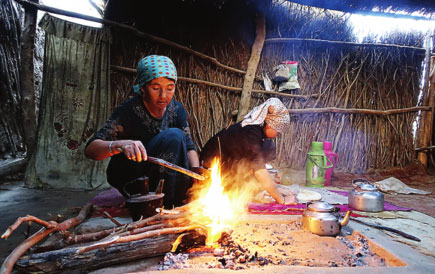
Women make a fire to cook in Daiyabuli township.
With just 1,347 residents, Daliyabuyi is the smallest township in the Xinjiang Uygur autonomous region, and until recently it was also the most remote. Now times are changing, thanks to the introduction of satellite TV and cellphones.
Memet Turson's face split into a huge grin as he stood in front of the house he built next to the sand dunes of the Taklimakan Desert. As a resident of Daliyabuyi, hidden deep in the world's second-largest desert in the Xinjiang Uygur autonomous region, the sight of an outsider is "a luxury", according to the 60-year-old herder.
When visitors see the local houses built from the wood of the desert poplar, the first question they ask is why the locals don't move out of the desert and enjoy a modern lifestyle.
"What we don't understand is why people measure everything by material worth nowadays. Why can't they see that we are happy in our own less-disturbed world?" Memet asked. "A good life is not about money, but about if one really enjoys it. Daliyabuyi is our heaven."
About 400 years ago, 20 Uygur families who were threatened by war left their land in what is now Yutian county in the southern prefecture of Hotan. They followed the Keriya River, which is fed by meltwater from the snow-covered Kunlun Mountains and gradually evaporates in the Taklimakan, a vast, expanse the locals call the "ocean of death".
Fifteen families settled on the river's west bank, while the others stayed on the east. Together, the families named their new home Daliyabuyi, which means "live along the river" in the Uygur language. They started from scratch, finding it difficult to adjust to desert life and exchange farming for herding sheep among the reed bushes.
An historical footnote
They called themselves the Keriya people, and they lived a self-sufficient life in the Taklimakan, using the wood of the desert poplar trees that grow along the riverbank to build houses. They burned rose willows for fuel and heating, and learned to use the hot sands to cook their food.
Eventually, they became cut off from the outside world and became a footnote in history until 1986, when a team exploring for oil reported seeing a "wild man" in the desert and submitted a report to the central government in Beijing.
"They said they had seen saw a man covered in fur and with a tail. It turned out to be a member of the Keriya people wearing his fur coat inside out and carrying an ax on his belt with the handle sticking out at the rear," said Azez Musar, commissioner of Hotan prefecture, who last year visited Daliyabuyi for the first time.
Having been alerted to the presence of the Keriya people, government officials traveled to Daliyabuyi to assess their needs. The residents said they wanted the status of the village to be raised, and in 1989, Daliyabuyi officially became the least-populated township in Xinjiang, Azez said.
The small, lost tribe has grown to 347 households and 1,347 residents. The people, scattered along the river, still use the old survival skills, especially for house construction and cooking, but the old ways are changing significantly even in the remotest parts of Xinjiang.


















































